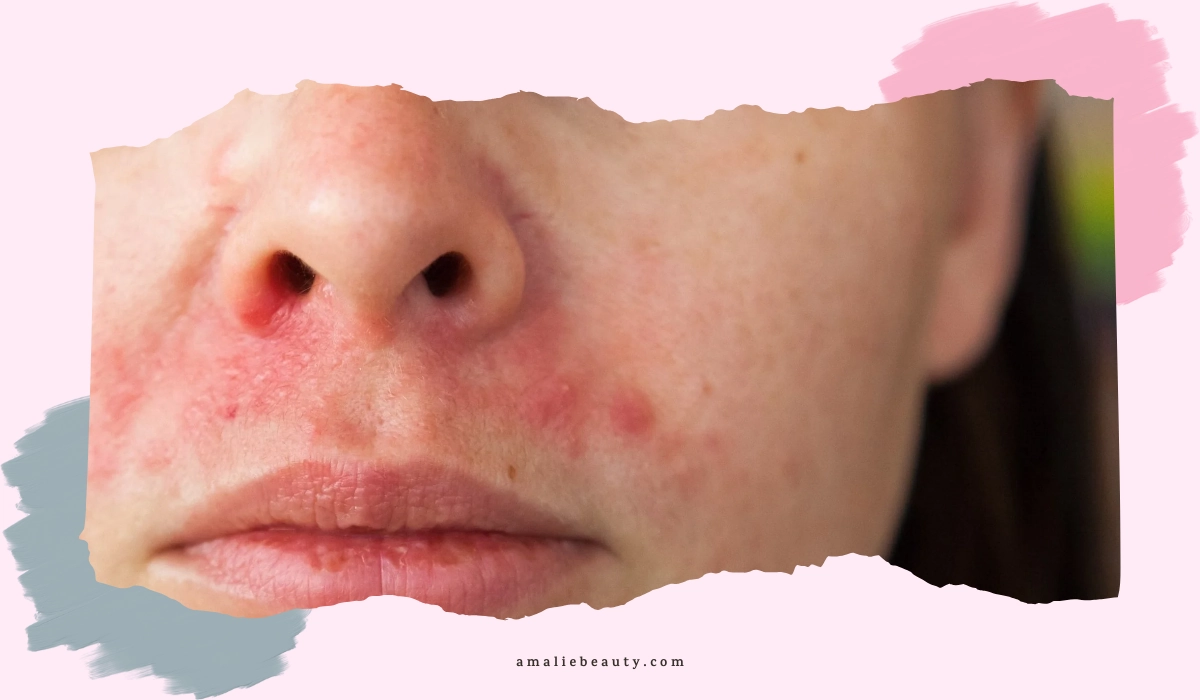Perioral dermatitis can be an unwelcome guest that affects our daily life and confidence. This is an inflammatory skin disease that primarily affects the area around the mouth and causes redness, bumps, and discomfort.
However, on the road to recovery, it is important to recognize the science that your perioral dermatitis is healing. These signs serve as encouraging milestones, or lifting your mood and giving you hope for a better, clearer future. So let us take a look at the encouraging indicators that your skin is on the road to recovery
What Is Perioral Dermatitis?
The etiology of perioral dermatitis is unknown, although various causes have been suggested, including topical corticosteroids and exposure to fluoride in water and toothpaste. This is not a true dermatitis as the name suggests.

Women and children of childbearing age are particularly affected. The rash usually begins in the nasolabial roof and spreads to the perioral area, leaving the area around the edges of the lips. The rash may also spread around the eye sockets and forehead.
Diagnosis Of perioral dermatitis
Clinical evaluation diagnosis of perioral dermatitis is based on appearance. Perioral dermatitis differs from acne in that there are no comedones, and it differs from rosacea in that there are no lesions around the mouth and eyes. Biopsy reveals follicular spongiosis and lymphocytic infiltration, although this is usually not clinically necessary.
How can I tell if my perioral dermatitis is healing?
1. The redness has decreased
Irritation is one of the most noticeable signs of healing perioral dermatitis, is there a reduction in redness and irritation in the affected area? The angry, inflamed skin that was once a source of frustration gradually begins to calm down, giving way to a more even skin tone. You may notice that the redness gradually disappears and your skin begins to regain its natural tone. This visible improvement gives you great confidence and reminds you that your skin is healing from the inside out.
2. Smoother texture and fewer bumps
Another encouraging sign of perioral dermatitis healing is an improvement in skin texture. As your body repairs itself naturally, you will notice a reduction in the number and size of the bumps that previously marred your skin. The affected area becomes smoother and the skin surface becomes more even. This positive change not only improves your appearance it also shows that underlying inflammation is reduced, giving your skin a chance to rejuvenate and repair
3 Itching relief and discomfort
Perioral dermatitis is often accompanied by unpleasant sensations such as itching and general discomfort. These irritating systems subside as the skin heals. The constant urge to scratch or rub your skin gradually subside and your skin will feel more comfortable. This reduction in discomfort benefits not only your physical but also your mental health and promotes a positive attitude as you continue your healing journey
As we move forward in the fight against perioral dermatitis, it is important to recognize signs that your skin is healing. Reduced redness and irritation, smoother texture fewer bumps, and less itching and discomfort are our promising indicators of improvement. Embrace these positive changes and use them as motivation to continue your journey to clearer, healthier skin.
Signs of Worsening perioral dermatitis
Perioral dermatitis caused by topical steroid use can be a skin condition that is difficult to treat. A potential rebound effect that gets worse before it gets better can lead people to believe they are not making progress
Outside of the rebound stage of perioral dermatitis, there are signs that the skin is not healing properly. This may be due to an infection or other skin disease occurring at the same time as perioral dermatitis.
Signs of new infections, such as swelling or discharge from the wounds, indicate that there may be a bacterial infection that needs treatment.
If you do not follow your doctor’s treatment instructions or have other skin diseases at the same time, the healing of perioral dermatitis may be hindered. It may happen.
Perioral dermatitis can worsen when topical steroid use is discontinued so it may be difficult for some people to resume using steroid creams after noticing a worsening of their facial appearance. This perpetuates the cycle and prevents healing.
Triggers such as heavy facial moisturizer, makeup, fascia oil, and hormonal changes can also impede healing.
Find the management plan for your symptoms
The best management plan for your perioral dermatitis symptoms should be obtained from your healthcare provider. They can customize your plan to suit your situation and symptoms. Your plan may include taking prescription medications and avoiding topical steroids and skin irritants.
➡️Skincare and sunscreen
Home self-care methods to treat perioral dermatitis symptoms include: gently washing your face with lukewarm water without soap. Don’t rub your face. Avoid using facial creams and cosmetics. Cover your face with a hat when you are in the sun and use sunscreens designed for more sensitive skin, such as mineral sunscreens
➡️Topical or sometimes oral antibiotics
Treatment of perioral dermatitis should include discontinuation of dental fluoride products and topical corticosteroids (if used) and topical antibiotics (e.g erythromycin 2% or metronidazole gel or cream (0.75% or twice a day) if no reaction occurs administer doxycycline or minocycline 50 to 100 mg orally for 4 weeks.
Tetracycline 250 to 500 mg orally twice a day. Administered twice daily (between meals) for 4 weeks then taper to the lowest effective dose. Unlike acne, antibiotics can usually be discontinued. Topical pimecrolimus (for 2 years and older) also reduces disease severity.
Summary
Perioral dermatitis is a skin disease that causes a rash around the mouth, it can be caused by the use of topical steroid creams, toothpaste, strong facial moisturizers, or other skin irritants.
The focus of treatment is to eliminate the trigger and treat it with antibiotics if necessary. Perioral dermatitis caused by topical steroids can get worse if you stop using them before they get better. Consult your doctor for specific treatment options for quick healing.

